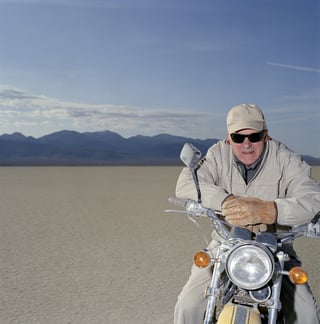This season has been the best one since the recession, but you're probably thinking the same thing Matt Levatich, the CEO of Harley Davidson, is thinking: Boomers are getting old, and Millennials aren't buying.
You have to crack the Millennial code. The hype about them won't help, obviously, but the reality will, including the surprising reality about how they handle money.
Thankfully Boomers kept you afloat this year. Consumer spending went up 3% generally speaking, but spending on motorcycles spiked 7.4%. Awesome.
Right about now prices are softening so dealerships can clear their showrooms, especially since all major OEMs will release new models this Fall. That's held auction values in check, and we certainly hope you scored one or two lots on that market -- especially since the pre-owned segment has performed so well.
Learning from Harley Davidson
That said, Polaris (almost) figured out a way to compete in the pre-owned market with brand new Victories. Their partnership with Costco drove members to local Polaris dealerships to get special member pricing on everything from bikes to electric utility vehicles. If they'd have lined up the bikes in the Costco warehouse, we'd be alarmed, but the fact that those sales went to dealerships probably means that every motorcycle manufacturer in the world is trying to figure out how to implement a similar promotion.
Polaris focused on their Victories because the Indian is clearly taking care of itself. Harley Davidson scaled back production and even offered discounts up to $3,000 to counter the Indian assault -- only to announce, in the process of explaining a ten-point drop in their stock price, that they've abandoned that strategy for fear of cheapening the brand.They used to control 58% of the heavyweight market; it's now down to 51%, and yes, that's an Indian zooming up from behind.
Of course the dollar's surge in value has undermined the export market and has made Harleys much more expensive abroad, which also impacted their sales numbers, but Levatich isn't concerned about international currency fluctuations.
His primary concern, as he told the Wall Street Journal, is to figure out how to sell bikes to Millennials. While defending their obsession with electronic devices, saying "It isn't bad; it's just different," he also expects that at some point Millennials "are going to want to actually live for real, and I think we have a product that has a great fit with that outlet."
He was referring to his street models, priced in the $7,000 range, and to the LiveWire, the electric bike he introduced last year to much fanfare.
The LiveWire already has everything it needs to become the urban hit Levatich expects it to become, except for one thing. Current battery technology gives it, at best, a fifty mile range. Levatich says he needs at least twice that to build a viable motorcycle, and so we'll have to wait two or three years for battery technology to advance.
Millennial concerns dominate Harley's thinking about conventional motorcycles as well. The same currency equation that makes it hard to sell Harley's in Japan makes it really cheap to buy a Honda in America.
Millennials Center Stage
Because of that, the models that will get all the attention in the short term will be the ones that appeal to Millennials. And the Boomers? Since nearly ten thousand of them turn sixty-five every day, theoretically maturing out of the motorcycle market, the Harleys targeted to them may be allowed to fade away.
So if the name of the game is getting Millennial buyers into your store, now might be the perfect time to line up some marketing work for the slow months this winter. The Millennials have been studied to death, and a lot is known about selling to them.
And Levatich is right: their obsession with their digital lives is not bad, it's just different, and the faster you can bring your shop up to speed, the more you'll appeal to the next big market. The Millennials do, afterall, outnumer the Boomers.
Looking at your operations might give you insights into what needs to change to make sure you impress your Millennial customers (more on how to close them below).
For example, do you keep your retail fianance promotions in a binder? Do you pencil in changes? Does it require a magnifying glass and several minutes of deciphering someone else's handwriting to answer a customer question like, "I heard you had a deal on a Street 500?"
If it does, then that's a process you might want to streamline. Millennial buyers work on Millennial time, which means they expect a continuous stream of input. A Millennial might find the binder entertaining if he was in an antique store with his girlfriend. But if he wants a Street 500, he absolutely needs you to be as cool as the bike is.
This is because Millennials are somewhat obsessed with the story about their shopping experience. This comes up in research over and over: a Millennial will share everything about his experience with his social network, and because of that, he might take his business elsewhere if you don't provide the right entertainment to make his Facebook post about you "Like-worthy."
Even if you do something as simple as replacing the binder with a document your salesperson can search on his phone, you'll move that Millennial sale forward. You're not a quaint antique store, where the notebook might add to the story. You're selling cutting-edge technology, and the sale goes more smoothly if you look like it.
Along those same lines, Millennials find the act of researching their purchase at least as compelling as the purchase itself. That's also part of the experience of shopping, and ultimately makes for a better story.
Because of that, your website may be another great place to focus for your attention during the slow months. There's a new term for the way Millennials use it: Fauxsumerism, as in "fake consumerism."
Top Four Winter Projects for the Millennial Market
In the same way a Millennial will show up already knowing all the technical specs for the Street 500, which he learned on the web, he will also choose to visit your shop because of what he saw, and read, on the web.
The reading part is much more important than most merchants realize. One of the studies about Millennials found that even when they're at work, four out of ten of them prefer electronic communication to talking. Millennials read continuously, and they're so accustomed to being innundated with messages that they no longer sort them into "advertisment" and "not an advertisement" the way Boomers do. Those categories still let through too much noise, and besides, Millennials don't want to filter out every single ad.
So they sort everything into "authentic" and "inauthentic," meaning "real" and "poser." All you have to do is prove that you're real.
Nationwide, only a tiny fraction of small businesses cash in on this phenomenon. Here's how you can:
And your fourth project? That one's all about closing the sale.
Since Millennials took a blow to the head in the Recession, they're the most financially conservative generation since the Great Depression. They dislike debt, and most of them were forced to carry a lot of it just to get through school. Trying to close a sale by adding to their debt burden can quickly backfire.
There is one way you can offer a payment plan that is not finanicing, does not require a credit check, but that can still match your buyer's outlay to his cashflow. Millennials use checks for two things: paying rent, and buying something that costs more than $100. Let them know about this option on your website, and they'll bring the checkbook with them. Find out how here.



